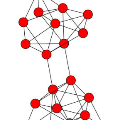Network embedding is the process of learning low-dimensional representations for nodes in a network, while preserving node features. Existing studies only leverage network structure information and focus on preserving structural features. However, nodes in real-world networks often have a rich set of attributes providing extra semantic information. It has been demonstrated that both structural and attribute features are important for network analysis tasks. To preserve both features, we investigate the problem of integrating structure and attribute information to perform network embedding and propose a Multimodal Deep Network Embedding (MDNE) method. MDNE captures the non-linear network structures and the complex interactions among structures and attributes, using a deep model consisting of multiple layers of non-linear functions. Since structures and attributes are two different types of information, a multimodal learning method is adopted to pre-process them and help the model to better capture the correlations between node structure and attribute information. We employ both structural proximity and attribute proximity in the loss function to preserve the respective features and the representations are obtained by minimizing the loss function. Results of extensive experiments on four real-world datasets show that the proposed method performs significantly better than baselines on a variety of tasks, which demonstrate the effectiveness and generality of our method.
翻译:网络嵌入是学习网络中节点的低维表示过程,同时保存节点特征。现有研究只利用网络结构信息,并侧重于保护结构特征。然而,现实世界网络中的节点往往具有提供额外语义信息的丰富属性。已经证明,结构和属性特征对于网络分析任务都很重要。为了保存这两个特征,我们调查整合结构和属性信息以进行网络嵌入并提议多式深网络嵌入(MDNE)方法的问题。MDNE利用由多层非线性功能组成的深层模型,捕捉非线性网络结构结构和结构和结构与属性之间的复杂互动。由于结构和属性是两种不同类型的信息,因此采用了多式学习方法进行预处理并帮助模型更好地捕结点结构与属性信息之间的关联。我们使用结构接近和属性在损失功能中的接近性来维护各自的特征,通过最大限度地减少损失功能来获取。四个真实世界数据集的广泛实验结果显示,拟议的方法比一般任务和基准要好得多。










